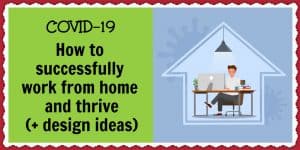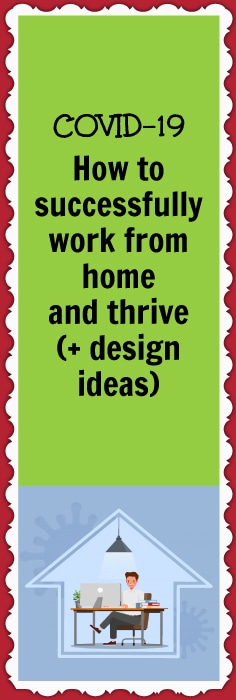The world as we know it looks and feels very different right now. A lot has changed. And we might find ourselves struggling to adapt. In light of what’s going on, I wanted to make a post to help you to not only cope but also feel better… at least a little bit.
Many of us are working from home now and that transition can be tough for some people. If you’re not used to working from home, you might have a hard time staying organized and productive.
So the first thing I wanted to offer in this post is a list of work-from-home productivity tips. I’ve had a lot of experience working from home throughout my career so I can personally say that these tips really help to make a difference.
The next thing I wanted to share is some design ideas I came up with in response to what’s happening. You could use them to raise money for COVID-19 or other charitable endeavors, and I go over a list of places you can donate to.
Lastly, I share a list of resources to help you stay positive, active, and engaged while we’re trudging our way through this situation. A lot has changed. But we can choose to adapt and make the most of a tough situation. And these resources can help us do that.
That said, let’s start by diving into the list of tips to stay more productive while working from home.
Work from home productivity tips
Create a routine
When you work from home (and don’t usually), act like you’re still going into work and try to maintain a routine.
For example, wake up at around the same time each day, eat breakfast, exercise, then sit down to work. If there’s something you enjoy doing for fun, such as taking walks, reading a book, or binge-watching a TV show, make that part of your routine as well. Practicing self-care and finding ways to continue enjoying life are super important right now.
Your work-from-home routine doesn’t have to be exactly like what you did each day pre-COVID-19, though. You can totally honor the fact that you now have more flexibility with your schedule.
So if you’re a morning person, start your day early. But if you’re a night owl, don’t feel like you have to continue waking up at 7 AM. Stay up late and sleep in late if that’s what feels best to you. Just be consistent. You don’t have to maintain a 9-5 schedule unless your workplace expects you to, but creating a routine, timelines, and structure is really helpful in terms of staying productive.
Take a shower; get dressed
This falls under the category of creating a routine. But I feel it should be a separate point as well because it’s important.
When you work from home, it can be super tempting to stay in your pajamas all day and skip showers and other forms of grooming and personal hygiene. But try to resist those urges.
Taking a shower and getting dressed helps you feel more put together so you can get into “work mode.” You don’t have to put on a suit or anything formal. Just change out of whatever you slept in into something else.
You definitely can still be comfortable. You can still wear sweatpants or yoga pants. You just want to separate sleep/lounge mode from work mode. And showering and putting on fresh clothes helps with that.
Have a designated workspace
Not everyone will be able to do this. But if you have the room in your house or apartment as well as the resources (e.g. a desk and chair), create a designated workspace (and wherever you work, make sure your setup supports your body, especially your back).
Your workspace doesn’t have to be an entire, separate room. It could be just a table and chair set up in the corner of your bedroom. You just want to avoid working from your bed or while sitting on the couch with the TV on.
And don’t mix your personal and professional responsibilities. For example, if you try to juggle doing a load of laundry while you’re in the process of writing a blog post, you’re going to be less effective at both tasks.
A lot of people think multitasking is a good thing. But it really isn’t. You won’t be as productive because you’re context-switching and that takes up mental bandwidth. It takes time to get back into the swing of things every time you switch tasks, so you end up spending more time on each task than if you had performed them separately.
Also, keep your phone and other distractions out of your designated workspace as much as you can. You might want to use a website blocker as well. If you were at your office, you wouldn’t be able to spend hours on Instagram or YouTube. So if it’s tempting for you to do that while working from home, use a website blocker. You can find a list of options here.
Establish priorities
When you’re on your own working from home, especially if you’re not used to it, staying organized can be challenging. To help stay on track, I recommend creating daily, weekly, and monthly priority lists.
Keep the lists simple and focused, and keep your daily priorities to no more than 3-4.
Now, when I say “priorities,” I don’t mean tasks, per se. A priority is something like “drive more traffic to my store” whereas “hire someone on Fiverr to create backlinks to my store” is a task that serves your traffic-driving priority.
Therefore, creating a list of 3-4 priorities doesn’t mean you have only 3-4 things to do that day. There are tons of traffic-driving strategies you can employ so you might actually end up with a sizable task list.
To help you come up with your daily, weekly, and monthly priorities, try reverse-engineering your goals (i.e. starting with the “big picture” and then working your way backward to figure out all of the tasks you need to complete to achieve your “big picture” goals). You can learn more about that process here.
Knowing what to focus on each day, week, and month helps ensure you’re making the most efficient use of your time. It keeps you on track so you don’t start chasing too many rabbits or let your big-picture goals get derailed. I highly recommend doing this.
Have a detailed to-do list
I know I just said to keep it simple with your priority lists. But you want to drill down and get very specific with your to-do lists. Your priorities speak more to the bigger picture whereas your to-do lists involve everything that needs to get done.
You want to include both personal and professional to-dos on your list. And, when appropriate, you might want to include a duration of time for certain activities as well. For example…
- Meditate for 15 minutes
- Exercise for 30 minutes
- Check emails for 15 minutes
- List 10 new products on my store
- Promote new listings on social media (Twitter, Facebook, Instagram, Pinterest)
- Write 300-400-word blog post
- Skype meeting with my mentor for 30 minutes
…and so on all the way through to the end of the day.
Include everything you need to do for your professional responsibilities as well as for your personal responsibilities, including chores and exercise. And as your day progresses, cross the items off your list.
There is something SO satisfying about crossing items off a to-do list. It gives you a sense of accomplishment and pride in your work, which, in turn, helps you stay productive.
Take breathers
You don’t want to work straight through your entire day. You need to take breathers. Get up, walk around, eat something, etc. You need to change your space every once in a while so you don’t get stagnant and lose steam.
Taking a breather helps reinvigorate your brain so you can stay productive. You need to step away from your computer so you can keep your creative juices flowing.
I recommend getting up to stretch at least once an hour and then scheduling in two or three 10-15-minute long breaks throughout the day. You should also make time to have a lunch break.
Sitting all day long is one of the worst things you can do to your body. Plus, if you stare at a computer screen for too long, it can cause eye strain. There’s a 20-20-20 rule that says every 20 minutes, look at something 20 feet away for 20 seconds to combat eye strain and eye fatigue.
When you work from home, you want to be as productive as possible, but you need to take care of yourself at the same time.
Set the mood
Setting the mood is another way to make the transition from lounge mode to work mode more deliberate and “official.” Try doing things that engage all of your senses to trigger your body and mind into thinking it’s work time.
You can do things like rubbing essential oils on your hands or turning on an essential oil diffuser to fill your workspace with pleasant scents. You can make yourself a cup of coffee or tea. Or, you can light a candle or turn on a specific type of music – whatever works best for you.
Meal prep ahead of time
Meal-prepping (ideally, the night before) reduces decision fatigue and saves time during your working hours. Instead of staring into the fridge wondering what to eat, you want to just get up and grab something without having to put any thought into it.
Meal-prepping also makes it easier to eat healthily. When you have something already prepared, you’re more likely to choose that option instead of grabbing whatever’s readily available, like a bag of chips.
If you have the resources, you might also want to do all of your meal-prepping on one day. For example, on Sunday, you could whip up a big batch of soup or make a lasagna – anything that would create lots of leftovers so you don’t have to cook every night.
Of course, you do then end up eating the same things over and over. So when and how often you meal-prep is up to you.
Have an end-of-the-day routine
This one is really important. When you work from home, you want to have a hard stop time because it’s all too easy for work time to bleed into personal time if you aren’t conscious about it. And it’s good to have a clear separation between the two.
So decide how many hours you want/need to work. Then, decide when you want to wake up and start work, and plan your stop time accordingly.
Creating a hard stop time is just the first step, though. It’s also good to have an end-of-the-day routine to help you prepare for the next day and transition out of work mode.
Your end-of-the-day routine could include writing down your to-do list for the following day or designating the final 15 minutes of your day to check your email one more time.
It’s good to have a ritual for both getting into and out of work mode each day. That way, you can maintain more of a sense of balance in your life so you’re less likely to burn out.
Design ideas
As another way to help you stay productive during this tough time, I thought it would be helpful to share some new design ideas in response to what’s going on.
This way you could possibly create some designs and donate money to charities that you support.
One idea I thought of was “thank you gift” designs for people who are continuing to work, often putting themselves at risk, to keep us safe – emotionally and physically – and make sure our needs get met.
Here’s the list of people I came up with:
All medical professionals, such as…
doctors
nurses
paramedics
medical assistants
EMTs
first responders
medical technologists
…as well as…
pastors
priests
nuns
rabbis
counselors
caregivers
community leaders
scientists
grocery store workers
warehouse workers
delivery drivers
truck drivers
Thank you gift messages could include things like…
Thank you for being the best [insert profession]
Best [insert profession] ever
You’re an awesome [insert profession]. Keep it up!
There’s no better [insert profession] than you! If anyone says otherwise, I’ll punch them in the face.
Thank God for [insert profession]
Thank you for all that you do
…You can create options that can be personalized as well. For example…
[Insert name] is the best nurse practitioner in the world! – e.g. Maggie Smith is the best nurse practitioner in the world!
…You might also create designs with a humorous spin – designs related to losing track of what day it is, social distancing being an introvert’s dream, or the way toilet paper is now a precious commodity (I’ve seen people using rolls of toilet paper icons in place of zeros or Os in their designs).
There are TONS of funny memes circulating social media that offer loads of inspiration for design ideas. COVID-19 is a serious matter and we all need to be mindful of what’s at stake. But when times are tough, as they are right now, finding humor in the situation helps people connect and feel more hopeful and less alone.
Be careful in your titles and tags, however, as both Amazon and Etsy, and possibly eBay, are being very strict against listings that use any words specifically related to “virus,” “coronavirus,” “covid,” etc.
Organizations you can donate to
Anytime a crisis occurs, the door opens to all kinds of opportunities to help, one of which is donating to worthwhile causes.
Of course, I’m not saying you should or have to do this. Not everyone has the means and you might be struggling right now. This is just a suggestion for anyone who can and wants to donate.
The following organizations offer the kind of aid that people need most right now. So, again, if there’s room in your budget, these are great organizations to send donations to:
Feeding America
No Kid Hungry
Meals on Wheels
The CDC Foundation
Center for Disaster Philanthropy
Save the Children
UNICEF
Global Giving
NOTE: Anytime you make a donation, please keep in mind that not all charities are equally worthy of your contributions.
Sometimes, a big percentage of the proceeds go toward covering the organization’s administrative expenses. Plus, some “charities” are outright scams.
To help you donate wisely, here is a list of resources to check out:
BBB Wise Giving Alliance
Charity Navigator
Charity Watch
GuideStar
How to donate a portion of your Low Hanging System proceeds
If you’re selling on Amazon, Etsy, or eBay via the Low Hanging System, you can donate a portion of your proceeds to charity. I really love this idea, especially for any COVID-19-inspired designs you create.
eBay specifically has an eBay for Charity program where you can choose a percentage of your final listing fee to donate to a charity of your choice. The minimum contribution is 10%. If you want to donate another way, here are their guidelines.
Etsy doesn’t have an official donation program, but they have an article encouraging working with nonprofits and sharing ideas on how you can gain more exposure. You can check out their guidelines and learn more here.
I haven’t found an official article for Amazon, but some forum threads suggest putting information in your About Us section as a great place to tell people what you and your shop stand for.
Resources to stay positive
Let’s be honest, there is A LOT of negativity circulating in the news these days. You obviously want to stay informed so you know what you need to do to take of yourself, your family, and others. But too much exposure to negative news can take a toll on your mental health. It can make you feel…
- anxious
- overwhelmed
- frustrated
- angry
- sad
…or all of the above.
There are a few resources I’d love to share with you:
Don’t Get Sucked Into Bad News – I wrote this book back in 2018. I wasn’t sure if it was still relevant now (I haven’t been through it), but a friend texted me and said this has been her “bible” through these times, so hopefully it helps.
Here are a few other helpful (and free) outlets I found that can help you maintain a positive outlook:
Good News Network
Positive News
The Optimist Daily
“Some Good News” with John Krasinski
EllenTube
The Happy News
And if you’re struggling to find things to do to occupy your time, here are some suggestions for that:
Audible – Find a huge selection of audiobooks to listen to. It’s free to try for 30 days.
Netflix Party – Watch TV shows and movies with your friends while social distancing. It’s free to use with a Netflix subscription.
Nike Run Club – This is a free app that offers coaching, tracking, and guided runs and walks.
Centre – This program comes from actor Chris Hemsworth and it offers workouts you can do from home, meal plans, and guided meditations. There’s a free 6-week trial.
Daily Burn – This is another fitness program, offering thousands of workouts, including cardio, pilates, and strength training. It’s free to try for 30 days.
Insight Timer – Free meditation app.
The Mindfulness App – Another free meditation app.
I really hope this list of tips and resources helps you cope with everything that’s going on in the world a little bit better. If you have any other suggestions or advice, please leave a comment below. Also, if you enjoyed this post, please share it with your friends and followers.





